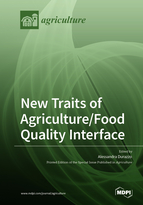New Traits of Agriculture/Food Quality Interface
A special issue of Agriculture (ISSN 2077-0472). This special issue belongs to the section "Agricultural Product Quality and Safety".
Deadline for manuscript submissions: closed (10 July 2021) | Viewed by 42061
Special Issue Editor
Interests: bioactive compounds; natural products; nutraceuticals; antioxidants; dietary supplements; food quality; nutrition; food composition databases; bioavailability, metabolic pathway; nanoformulations
Special Issues, Collections and Topics in MDPI journals
Special Issue Information
Dear Colleagues,
There is a close linkage between food and territory. The current challenges can be located in precision agriculture and food metrology from the perspective of monitoring and improving food quality, addressing the promotion of diversity of agroecosystems and diets. Research studies describing factors affecting food quality—such as agronomic conditions, post-harvest elicitors, cultivar selection, harvest date, or environmental influences—are welcome. Sustainable environmental and innovative practices should be promoted.
Advanced techniques, such as mass spectrometry, infrared, and Raman spectroscopy in the monitoring and control of foodstuffs for modeling the agrofood system should be considered. Innovative green technologies should be taken into account. Targeting food approaches should be promoted. Chemometrics applications are welcome.
This issue promotes highly interdisciplinary studies including disciplines from agriculture and biology, chemistry, and nutrition. All types of articles, such as original research, opinions, and reviews, are welcome.
Dr. Alessandra Durazzo
Guest Editor
Manuscript Submission Information
Manuscripts should be submitted online at www.mdpi.com by registering and logging in to this website. Once you are registered, click here to go to the submission form. Manuscripts can be submitted until the deadline. All submissions that pass pre-check are peer-reviewed. Accepted papers will be published continuously in the journal (as soon as accepted) and will be listed together on the special issue website. Research articles, review articles as well as short communications are invited. For planned papers, a title and short abstract (about 100 words) can be sent to the Editorial Office for announcement on this website.
Submitted manuscripts should not have been published previously, nor be under consideration for publication elsewhere (except conference proceedings papers). All manuscripts are thoroughly refereed through a single-blind peer-review process. A guide for authors and other relevant information for submission of manuscripts is available on the Instructions for Authors page. Agriculture is an international peer-reviewed open access monthly journal published by MDPI.
Please visit the Instructions for Authors page before submitting a manuscript. The Article Processing Charge (APC) for publication in this open access journal is 2600 CHF (Swiss Francs). Submitted papers should be well formatted and use good English. Authors may use MDPI's English editing service prior to publication or during author revisions.
Keywords
- Agronomic practices
- Precision agriculture
- Food metrology
- Food monitoring
- Chemometrics
- Quality control
- Advanced techniques






